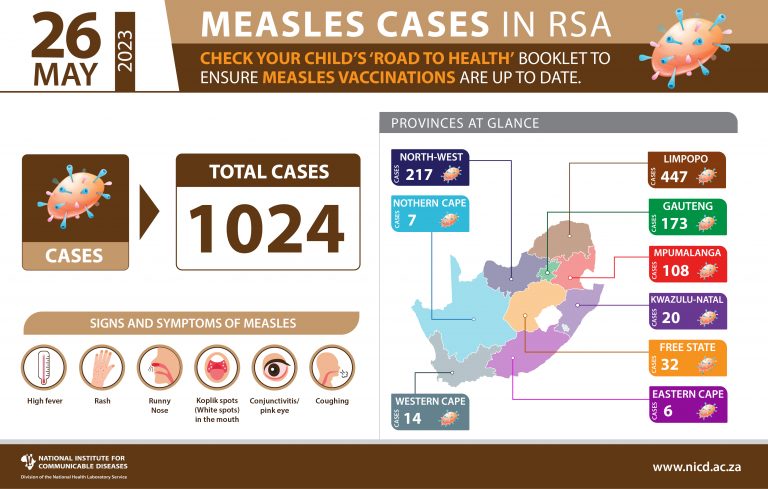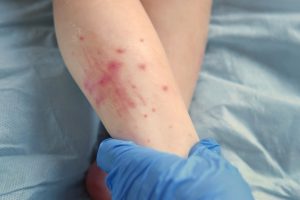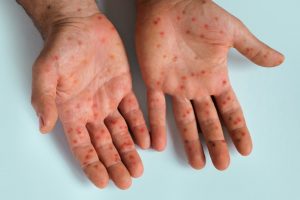Issued by the National Institute for Communicable Diseases based on laboratory testing data
Highlights
- The NICD has tested 6010 serum samples for measles since epidemiological week 40, 2022, of which 1024 (17%) were confirmed positive, all from outbreak-affected provinces. In the past weeks (week 19 up until week 20, 16/05/2023) there have been 19 laboratory-confirmed measles cases detected across the country, of which the majority were from Limpopo (14).
- The percentage of samples testing positive (PTP) increased from 29% of 65 samples tested in week 18 to 22% of 74 samples tested in week 19.
- Measles outbreak has been declared in all the provinces in South Africa except for the Eastern Cape. In week 19, 16 new cases were reported from Limpopo province. No new cases were reported in Mpumalanga, Northern Cape, Western Cape and KwaZulu-Natal provinces in the past four weeks.
- The measles strain detected in Limpopo province and North West province is genotype D8 which is similar to the strain in Zimbabwe in the 2022 outbreak.
- Nationally, the reproduction number as of 2023-05-11 was estimated to be 0.8 (0.41 – 1.6), suggesting that infection incidence is likely decreasing. There is a 72% chance that the reproduction number was below 1 as of 2023-05-11.
- At the provincial level, the reproduction number as of 2023-05-11 was estimated to be 0.73 (0.48 – 1.1) in Limpopo and 0.69 (0.47 – 1) in Gauteng, suggesting that infection incidence is likely decreasing. Other provinces had too few recent cases for robust reproduction number estimation, suggesting limited ongoing transmission, if any.
- At the district level, the reproduction number as of 2023-05-11 was estimated to be 0.86 (0.62 – 1.2) in Waterberg and 0.57 (0.29 – 1) in Mopani, suggesting that infection incidence is likely decreasing. In contrast the reproduction number was estimated to be 0.36 (0.22 – 0.56) in Greater Sekhukhune and 0.32 (0.14 – 0.62) in Ekurhuleni Metro, suggesting that infection incidence is decreasing. Other districts had too few recent cases for robust reproduction number estimation, suggesting limited ongoing transmission, if any.
Outbreak overview
From epidemiological week 40, 2022 (ending 8 October 2022) to week 20, 2023 the NICD has tested 6010 serum samples for measles of which 1024 (17%) were confirmed measles cases. The number of samples submitted, and percentage of laboratory-confirmed measles-positive cases are shown in Figure 1. From epidemiological week 40 of 2022 to week 20 of 2023, 1018 laboratory-confirmed cases were reported from eight provinces with declared measles outbreaks; Limpopo (447 cases), Mpumalanga (108 cases), North West (217 cases), Gauteng (173 cases), Free State (32 cases), Western Cape (14), KwaZulu-Natal (20) and Northern Cape (7) (Table 1). The geographical distribution of cases across South Africa from week 40 of 2022 until week 20 of 2023 is shown in Figure 2The number of blood samples and throat swabs submitted to the NICD for measles serology and PCR testing increased from 65 in week 18 to 74 in week 19 (Figure 3).

Figure 1. Number of serum samples submitted to the NICD for measles, week 40 2022, until week 19, 2023, and the number (dark green) and % tested positive (red line), by epidemiological week using the date the specimen was collected. *Data from week 20 will be updated in next week’s situation report, when complete data from samples collected that week becomes available.

Figure 2. Distribution of laboratory-confirmed measles cases by testing site (red dots – the size of the dot indicates the number of cases from that facility) and district of South Africa (deepening colour of blue indicates the total number of cases by sub-district), from week 40 to week 20, 2023.

Figure 3. Number measles of tests conducted from week 40 2022, until week 20, 2023, by province and epidemiological week using the date the specimen was collected. *Data from week 20 represent partial data, and will be updated in next week’s situation report, when complete data from samples collected that week becomes available.





